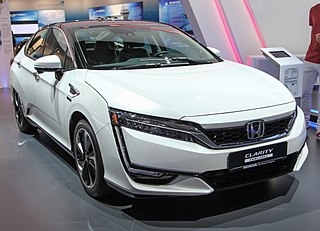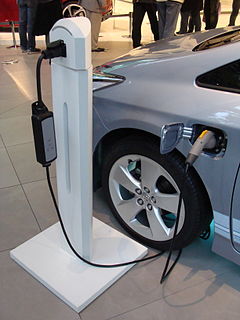The harmonized sales tax (HST) is a consumption tax in Canada. It is used in provinces where both the federal goods and services tax (GST) and the regional provincial sales tax (PST) have been combined into a single value added sales tax.
The Energy Tax Act is a law passed by the U.S. Congress as part of the National Energy Act. The objective of this law was shift from oil and gas supply toward energy conservation; thus, to promote fuel efficiency and renewable energy through taxes and tax credits.

A flexible-fuel vehicle (FFV) or dual-fuel vehicle is an alternative fuel vehicle with an internal combustion engine designed to run on more than one fuel, usually gasoline blended with either ethanol or methanol fuel, and both fuels are stored in the same common tank. Modern flex-fuel engines are capable of burning any proportion of the resulting blend in the combustion chamber as fuel injection and spark timing are adjusted automatically according to the actual blend detected by a fuel composition sensor. Flex-fuel vehicles are distinguished from bi-fuel vehicles, where two fuels are stored in separate tanks and the engine runs on one fuel at a time, for example, compressed natural gas (CNG), liquefied petroleum gas (LPG), or hydrogen.

The Honda Clarity is a nameplate used by Honda on alternative fuel vehicles. It was initially used only on hydrogen fuel-cell electric vehicles such as the 2008 Honda FCX Clarity, but in 2017 the nameplate was expanded to include the battery-electric Honda Clarity Electric and the plug-in hybrid electric Honda Clarity Plug-in Hybrid, in addition to the next generation Honda Clarity Fuel Cell.

A hybrid electric vehicle (HEV) is a type of hybrid vehicle that combines a conventional internal combustion engine (ICE) system with an electric propulsion system. The presence of the electric powertrain is intended to achieve either better fuel economy than a conventional vehicle or better performance. There is a variety of HEV types, and the degree to which each functions as an electric vehicle (EV) also varies. The most common form of HEV is the hybrid electric car, although hybrid electric trucks and buses also exist.

The Chevrolet Volt is a plug-in hybrid car manufactured by General Motors, also marketed in rebadged variants as the Holden Volt in Australia and New Zealand, Buick Velite 5 in China, and with a different fascia as the Vauxhall Ampera in the United Kingdom and as the Opel Ampera in the remainder of Europe. Volt production ended in February 2019.
The Vehicle Efficiency Incentive (VEI) was introduced in the 2007 Canadian federal government budget, aimed at promoting fuel-efficient vehicles. The VEI took effect on March 20, 2007, and it included a performance-based rebate program offering up to $2,000 for the purchase of a new fuel-efficient vehicle, a neutral treatment of a broad range of vehicles with average fuel-efficiency that were widely purchased by Canadians, and a new Green Levy on fuel-inefficient vehicles.
The Economic Stimulus Act of 2008 was an Act of Congress providing for several kinds of economic stimuli intended to boost the United States economy in 2008 and to avert a recession, or ameliorate economic conditions. The stimulus package was passed by the U.S. House of Representatives on January 29, 2008, and in a slightly different version by the U.S. Senate on February 7, 2008. The Senate version was then approved in the House the same day. It was signed into law on February 13, 2008 by President Bush with the support of both Democratic and Republican lawmakers. The law provides for tax rebates to low- and middle-income U.S. taxpayers, tax incentives to stimulate business investment, and an increase in the limits imposed on mortgages eligible for purchase by government-sponsored enterprises. The total cost of this bill was projected at $152 billion for 2008.
The main fuel tax in Australia is an excise tax, to which is added a Goods and Services Tax ("GST"). Both taxes are levied by the federal government. In Australia, like Canada, the GST is applied on top of the fuel excise tax. In some cases, businesses may be entitled to exemptions or rebates for fuel excise tax, including tax credits and certain excise-free fuel sources.
The U.S. Energy Policy Act of 2005 established a federal income tax credit of up to $3,400 for the purchase of new hybrid vehicles, purchased or placed into service after December 31, 2005. Vehicles purchased after December 31, 2010 are not eligible for this credit. The law limited the tax credits to the first 60,000 eligible vehicles per carmaker, meaning that credits for popular models will be phase out before the tax break's scheduled expiration date. Note these are credits — dollar for dollar tax savings — not merely deductions. The tax credit is to be phased out two calendar quarters after the manufacturer reaches 60,000 new cars sold in the following manner: it will be reduced to 50% if delivered in either the third or fourth quarter after the threshold is reached, to 25% in the fifth and sixth quarters, and 0% thereafter. The Internal Revenue Service is responsible for certifying that certain passenger autos and light trucks qualify for the credit and the amount of the credit.
The EcoAuto Rebate Program was a Canadian government program administered by Transport Canada to provide incentive to people to buy fuel-efficient vehicles, to protect the environment, through rebates. The program applied to vehicles purchased between March 20, 2007 and December 31, 2008. The EcoAuto Program affected eligible cars from 2006 to 2008.
A scrappage program is a government budget programme to promote the replacement of old vehicles with modern vehicles. Scrappage programmes generally have the dual aim of stimulating the automobile industry and removing inefficient, more polluting vehicles from the road. Many European countries have introduced large-scale scrappage programmes as an economic stimulus to increase market demand in the industrial sector during the global recession that began in 2008.

The Car Allowance Rebate System (CARS), colloquially known as "cash for clunkers", was a $3 billion U.S. federal scrappage program intended to provide economic incentives to U.S. residents to purchase a new, more fuel-efficient vehicle when trading in a less fuel-efficient vehicle. The program was promoted as providing stimulus to the economy by boosting auto sales, while putting safer, cleaner, and more fuel-efficient vehicles on the roadways.

The adoption of plug-in electric vehicles in the United States is supported by the American federal government, and several state and local governments. As of September 2018, cumulative sales in the U.S. totaled one million highway legal plug-in electric vehicles since the market launch of the Tesla Roadster in 2008. The American stock represented about 25% of the global plug-in car stock in 2017, and the U.S. had the world's third largest stock of plug-in passenger cars after China and Europe.

Electric car use by country varies worldwide, as the adoption of plug-in electric vehicles is affected by consumer demand, market prices and government incentives. Plug-in electric vehicles (PEVs) are generally divided into all-electric or battery electric vehicles (BEVs), that run only on batteries, and plug-in hybrids (PHEVs), that combine battery power with internal combustion engines. The popularity of electric vehicles has been expanding rapidly due to government subsidies, their increased range and lower battery costs, and environmental sensitivity. However, the stock of plug-in electric cars represented just about 1 out of every 250 motor vehicles on the world's roads by December 2018.

The stock of plug-in electric cars in Canada totaled 45,950 units at the end of 2017, consisting of 23,620 all-electric cars and 22,330 plug-in hybrids. Cumulative sales passed the 20,000 unit mark in May 2016, and the 30,000 unit mark in January 2017.

The Toyota Mirai is a mid-size hydrogen fuel cell car manufactured by Toyota, one of the first such sedan-like vehicles to be sold commercially. The Mirai was unveiled at the November 2014 Los Angeles Auto Show. As of December 2017, global sales totaled 5,300 Mirais. The top selling markets were the U.S. with 2,900 units, Japan with 2,100 and Europe with 200.

The stock of plug-in electric vehicles in California is the largest in the United States, with cumulative sales of over 500,000 plug-in cars by the end of November 2018. California is the largest U.S. car market with about 10% of all new car sales in the country, but has accounted for almost half of all plug-in cars sold in the American market since 2011. Since November 2016, China is the only country market that exceeds California in terms of cumulative plug-in electric car sales. In 2017, California's plug-in car market share reached 4.8%, while the national share was 1.1%. Also in 2017, the state's plug-in segment market share surpassed the take-rate of conventional hybrids (4.6%) for the first time. The plug-in market share rose to 7.8% in 2018, again ahead of conventional hybrids (4.1%), and for the first time sales of all-electric cars outsold conventional hybrids.












